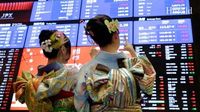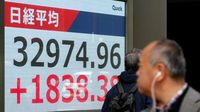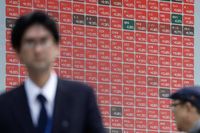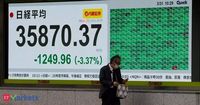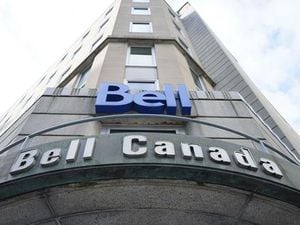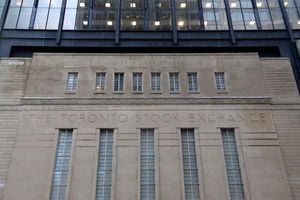Japan's Nikkei share average jumped 6% on Tuesday, April 8, 2025, rebounding from a 1-1/2-year low hit in the previous session, as investors reacted positively to signs of recovery in U.S. markets. As of 0020 GMT, the Nikkei index was up 5.9% at 32,959.59, while the broader Topix traded 6.14% higher at 2,428.64.
This recovery comes after a turbulent day on April 7, when the Nikkei 225 Index plummeted by 2,644 points, or 7.83%, finishing at 31,136.58. This marked the index’s worst single-day performance since the early days of the COVID-19 pandemic and reflected mounting fears over a global recession, U.S. tariff tensions, and a significant shift in investor sentiment across Asia.
On April 7, the Nikkei opened at 33,154.97 and reached a high of 33,158.87 before crashing to a low of 30,792.74, a new 52-week low. The drop below the 31,500 psychological level confirmed a full-blown correction, wiping out nearly two months’ worth of gains in a single session. Analysts attributed the collapse to growing concerns that the Trump administration’s proposed "reciprocal tariffs" could trigger a global trade war, significantly damaging export-heavy economies like Japan.
Despite the historic fall, analysts suggested that the Nikkei might attempt a technical rebound on April 8 as markets opened higher across Asia. The S&P 500 and the Dow closed lower, but the technology-heavy Nasdaq posted marginal gains on April 7, signaling potential recovery cues for Asian markets.
"Investors bought back stocks as they thought the shares were oversold. They saw signs of a market recovery as U.S. stock futures rose in Japan trade," said Takamasa Ikeda, senior portfolio manager at GCI Asset Management. The U.S. semiconductor index climbed 2.7% overnight, and S&P and Nasdaq futures each rose more than 1% in Asia trade on April 8.
Individual stocks showed remarkable rebounds on April 8. Chip-making equipment maker Tokyo Electron surged 8.85%, while chip-testing equipment maker Advantest jumped 11%. Bank shares also advanced significantly, with Mitsubishi UFJ Financial Group surging 12% and Mizuho Financial Group up 13%. All 33 industry sub-indexes of the Tokyo Stock Exchange saw gains, with the banking index leading the charge, soaring 11% to become the top performer.
However, the market's recovery is still fragile. "We’re entering rebound territory, but investor trust is fragile. We need global policy signals or central bank support for a real recovery," noted Hiroshi Yamada, Chief Strategist at Nikko Securities.
The volatility in the Nikkei was mirrored by other global markets. On April 7, the Dow Jones fell by 349 points (0.9%), and the S&P 500 ended 0.2% lower. The Nasdaq, however, managed to gain slightly by 0.1%. The Dow had been down as much as 1,700 points during the day before making a remarkable recovery, jumping nearly 900 points later in the morning.
Rumors circulated that President Trump would pause tariffs for 90 days, leading to a temporary rally in U.S. stocks. However, the White House quickly labeled this as "fake news," causing markets to drop again. Trump’s tariffs are seen as an attack on global trade systems, raising fears of a slowdown in global trade and affecting investor confidence.
While the Nikkei showed signs of recovery, other Asian markets had not fared as well. On April 7, Hong Kong stocks fell by 13.2%, marking their worst decline since the 1997 Asian financial crisis. Indian markets were also hit hard, with both the Sensex and Nifty experiencing their biggest single-day falls in 10 months due to fears that Trump’s trade policies might push the U.S. economy into a recession and increase inflation.
On April 7, the Sensex crashed by 2,226.79 points (2.95%) to close at 73,137.90, having fallen as much as 3,939.68 points (5.22%) during the day. Nifty dropped by 742.85 points (3.24%), closing at 22,161.60, and at one point was down 1,160.8 points (5.06%), touching 21,743.65.
As investors returned to the Tokyo market on April 8, much depended on Wall Street futures, currency movements, and broader Asia-Pacific sentiment. The rebound in the Nikkei could signal a cautious optimism among traders, but the underlying economic concerns and geopolitical tensions remain significant hurdles to sustained market stability.
In summary, the Nikkei's sharp rise on April 8, following a record drop, reflects the volatile nature of current markets influenced by U.S. trade policies. While there are signs of recovery, the path ahead remains uncertain, and investors are advised to proceed with caution.
